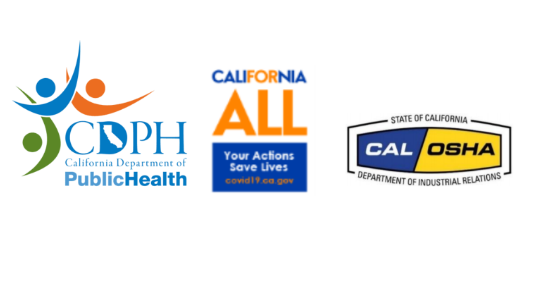Title Page
-
Conducted on
-
Prepared by
-
Location
Contents of Written Worksite Specific Plan
-
The person(s) responsible for implementing the plan.
-
A risk assessment and the measures that will be taken to prevent spread of the virus.
-
Training and communication with employees and employee representatives on the plan.
-
A process to check for compliance and to document and correct deficiencies.
-
A process to investigate COVID-cases, alert the local health department, and identify and isolate close workplace contacts of infected employees until they are tested.
-
Update the plan as necessary to prevent further cases.
Topics for Employee Training
-
Information on COVID-19, preventing spread, and who is especially vulnerable.
-
Self-screening at home, including temperature and/or symptom checks using CDC guidelines.
-
The importance of not coming to work if employees have a frequent cough, fever, difficulty breathing, chills, muscle pain, headache, sore throat, the recent loss of taste or smell, or if they or someone they live with has been diagnosed with COVID-19.
-
When to seek medical attention.
-
The importance of hand washing.
-
The importance of physical distancing, both at work and off work time.
-
Proper use of cloth face covers
Individual Control Measures and Screening
-
Symptom screenings and/or temperature checks.
-
Encourage workers who are sick or exhibiting symptoms of COVID-19 to stay home.
-
Encourage frequent handwashing and use of hand sanitizer.
-
Provide disposable gloves to workers using cleaners and disinfectants when required. Consider gloves as a supplement to frequent handwashing for other cleaning, tasks such as handling commonly touched items or conducting symptom screening.
-
Strongly recommend employee use of cloth face covers.
-
Communicate frequently to customers that they should use face masks/covers.
-
Housekeepers and others who must enter guest rooms should be provided with face covers.
-
Housekeeping must only service rooms when guests are not present.
-
Housekeepers should be instructed to minimize contact with guests’ personal belongings when cleaning.
-
Housekeepers should be instructed to have ventilation systems operating and/or windows open if possible, to increase air circulation.
-
Hotels should allow housekeepers extra time to clean rooms without loss of pay to account for required precautions and to allow them to conduct more thorough cleaning and disinfection of rooms between guests.
-
Guests and visitors should be screened upon arrival and asked to use hand sanitizer and to wear a face cover.
-
Appropriate signage should be prominently displayed at all entrances and strategically throughout the property on face covering and physical distancing.
Cleaning and Disinfecting Protocols
-
Perform thorough cleaning in high traffic areas.
-
Frequently disinfect commonly used surfaces.
-
Clean and sanitize shared equipment between each use.
-
Clean touchable surfaces between shifts or between users, whichever is more frequent.
-
Make hand sanitizer and other sanitary supplies readily available to employees.
-
Ensure that sanitary facilities stay operational and stocked at all times.
-
Use products approved for use against COVID-19 on the Environmental Protection Agency (EPA)-approved list and follow product instructions and Cal/OSHA requirements.
-
Adjust or modify hours and quotas to provide adequate time for additional cleaning.
-
Provide time for workers to implement cleaning practices before, during, and after shifts.
-
Install hands-free devices if possible, including motion sensor lights, contactless payment systems, automatic handwashing water, soap, paper towel dispensers, and timecard systems.
-
Encourage the use of debit or credit cards by customers.
-
Consider upgrades to improve air filtration and ventilation.
Additional Cleaning and Disinfecting Protocols for Hotel Operations
-
Remove reusable collateral from rooms. Critical information should be provided as single-use collateral and/or electronically posted.
-
Bag dirty linens for transport and wash at a high temperature and cleaned in accordance with CDC guidelines.
-
Consider leaving rooms vacant for 24 to 72 hours between occupancy.
-
Develop a quarantine and cleaning plan for rooms where an infected guest has been.
-
Install hand sanitizer dispensers throughout the property.
-
Consider providing guests an amenity bag during check-in containing face cover, hand sanitizer, and a COVID-19 awareness card.
Physical Distancing Guidelines
-
Implement measures to physically separate workers by at least six feet using measures such as physical partitions or visual cues (e.g., floor markings, colored tape, or signs to indicate to where workers should stand).
-
Use signage to remind customers of physical distancing at every opportunity.
-
Reconfigure, restrict or close breakrooms and create alternative space for breaks where physical distancing is possible.
-
Adjust in-person meetings, if they are necessary, to ensure physical distancing.
-
Stagger employee breaks, in compliance with wage and hour regulations, to maintain physical distancing protocols.
-
Guests should enter through doors that are either propped open, if possible, or are automated or manually operated by a dedicated gloved employee.
-
Implement peak period queueing procedures to enforce physical distancing.
-
Employees should not open the doors of cars or taxis.
-
Guest room service should use contactless pick-up and delivery protocols.
-
Limit food and beverage offerings to take-out and “contactless” room service until dine-in establishments are allowed to resume.
-
See detailed guidance for resumption of other facilities such as restaurants, salons, spas, fitness centers and golf courses.
Sign Off
-
Name and Signature














